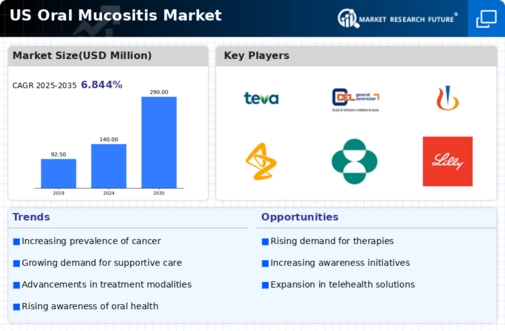Rising Geriatric Population
The oral mucositis market is also being driven by the rising geriatric population in the US. Older adults are more likely to develop oral mucositis due to age-related factors and the higher prevalence of chronic diseases, including cancer. As the population aged 65 and older continues to grow, the incidence of oral mucositis is expected to rise correspondingly. This demographic shift necessitates the development of targeted therapies and supportive care strategies to address the unique needs of elderly patients. The oral mucositis market must adapt to this changing landscape, focusing on creating solutions that cater specifically to older adults. This trend not only highlights the importance of specialized care but also presents opportunities for market players to innovate and expand their product offerings.
Advancements in Treatment Modalities
Recent advancements in treatment modalities are significantly influencing the oral mucositis market. The introduction of novel therapeutic agents, including biologics and targeted therapies, has shown promise in reducing the severity and duration of oral mucositis. For instance, the development of mucosal protectants and anti-inflammatory agents has provided healthcare professionals with more effective tools to manage this condition. As these innovative treatments gain regulatory approval and enter the market, they are expected to enhance patient care and drive market growth. Furthermore, the oral mucositis market is projected to reach approximately $1.5 billion by 2027, reflecting the increasing demand for effective solutions. This trend indicates a shift towards more sophisticated treatment options, which may lead to improved patient adherence and satisfaction.
Increased Focus on Clinical Research
An increased focus on clinical research is shaping the oral mucositis market. Ongoing studies aim to better understand the pathophysiology of oral mucositis and identify effective treatment strategies. This research is crucial for developing new therapies and improving existing ones. As clinical trials yield promising results, the oral mucositis market is likely to benefit from the introduction of new products that address unmet needs. Furthermore, collaboration between academic institutions and pharmaceutical companies is fostering innovation in this field. The commitment to advancing clinical research not only enhances the understanding of oral mucositis but also drives market growth by ensuring that effective treatments are available to patients.
Increasing Incidence of Cancer Treatments
The oral mucositis market is experiencing growth due to the rising incidence of cancer treatments, particularly chemotherapy and radiation therapy. These treatments often lead to oral mucositis as a side effect, affecting a significant number of patients. In the US, it is estimated that around 40% of patients undergoing chemotherapy develop some form of oral mucositis. This increasing patient population drives demand for effective treatment options, thereby expanding the oral mucositis market. The need for innovative therapies to manage this condition is becoming more pronounced, as healthcare providers seek to improve patient outcomes and quality of life. Consequently, pharmaceutical companies are investing in research and development to create new products tailored to this specific need, further propelling the oral mucositis market forward.
Growing Investment in Healthcare Infrastructure
The oral mucositis market is positively impacted by the growing investment in healthcare infrastructure across the US. Enhanced healthcare facilities and improved access to treatment options are crucial for managing oral mucositis effectively. As hospitals and clinics upgrade their services and technologies, the availability of specialized care for patients suffering from oral mucositis increases. This investment is likely to lead to better patient outcomes and higher demand for effective therapies. Additionally, the integration of multidisciplinary approaches in treatment plans is becoming more common, further supporting the oral mucositis market. As healthcare systems evolve, the focus on comprehensive care will likely drive the development and adoption of innovative solutions for managing oral mucositis.






















Leave a Comment